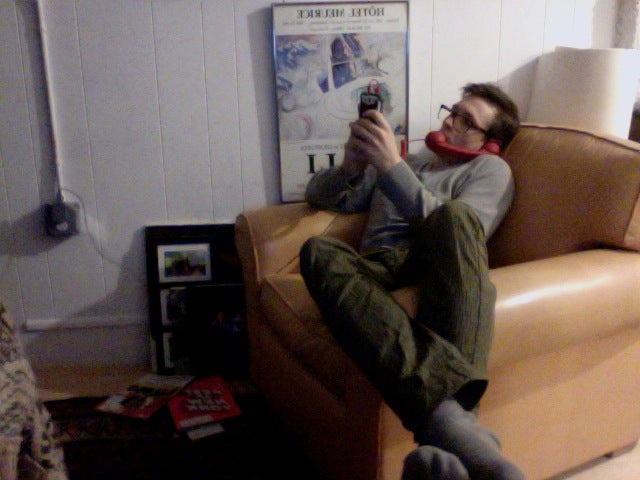
The term “performance art” comes as a loaded and convoluted one these days, something as confusing as it is fascinating. In its foundations, performance art refers to an artwork dependent on the presence of the artist hisself or herself, rather than an artifact made by him or her. But there’s also something outside of what conventional notions of theater or other performance imply. There’s a sense of the artist’s autonomy in composition and endurance in performance, the work’s social critique, the difficulty to replicate the action in presence and effect—these are the markers of a great work of performance art. We’ve collected The 25 Best Performance Art Pieces of All Time here—some are vaguely not safe for work.
25. Cabaret Voltaire

25. Cabaret Voltaire by Various Artists, 1916
The inklings of what performance art could achieve, outside of a theatrical context, stem from the Dada movement's home base in Zurich, at the legendary Cabaret Voltaire. Founded in the backroom of the Holländische Meierei tavern in 1916 by Hugo Ball and Emmy Hemmings, the Cabaret Voltaire was a space of raucous artistic experimentation that many times led to the uproar of the crowd-more than once, the audience attacked the stage of the Cabaret in protest. The radical, chaotic performances happening here included new forms of poetry, avant-garde music, mutations of costumes, paintings, and simultaneous performance of all these. The Cabaret Voltaire helped expand international cultural ideas, as refugees from all over Europe during World War I found a creative outlet in the Dada Haus, as it was also known.
24. Mishima's Suicide

24. Mishima's Suicide by Yukio Mishima, 1970
On November 25, 1970, the famed post-war Japanese writer-turned political activist Yukio Mishima attempted a political coup that culminated with his ritual seppuku suicide. Mishima and five of his disciples in his Shield Society forced entry into the offices of Japanese Self-Defense Forces. Mishima captured and bound the commander, General Masuda, and ordered him to convene the 800 troops present in the courtyard below his office. Mishima planned a thirty-minute speech to the gathered soldiers below, outlining his disappointments with the current political climate and the failures of the young political movment. But he was shouted down with jeers after only seven minutes. Mishima then went inside and cut his belly open in the ritual samurai manner.
23. Triadic Ballet

23. Triadic Ballet by Oskar Schlemmer, 1922
Oskar Schlemmer's radical notion that all art, including dance, was artificial in part led to his Triadic Ballet, one of the most widely performed avant-garde dances. A major signal of the Bauhuas movement, Triadic Ballet cemented its place in history as one of the first examples of multimedia performance. Schlemmer even created his costumes first, and then designed the choreography around them; however, the original choreography has since been lost and is recreated based on research and intuition.Oskar Schlemmer's radical notion that all art, including dance, was artificial in part led to his Triadic Ballet, one of the most widely performed avant-garde dances. The 1922 lynchpin of the Bauhuas movement, Triadic Ballet cemented its place in history as one of the first examples of multimedia performance. Schlemmer even created his costumes first, and then designed the choreography around them; however, the original choreography has since been lost and is recreated based on research and intuition.
image via
22. Seedbed

21. The Joy of Life

20. Parade

20. Parade by Pablo Picasso & Ballet Russe, 1916-1917
Though there had been collaboration on ballets and operas previously, none had broken free of traditional notions of the forms quite like this group of artists did in the early 20th century. This was the first time Picasso and Satie worked on a ballet, or collaborated with one another at all, and the result was uncompromising to both contributors' outlooks. Not only did Picasso translate his Cubist perspective to costume design, but also Satie employed a number of unconventional instruments for a culturally disruptive and aggravating spectacle-it was one of many instances of modern art that caused the audience to riot.
image via
19. Wall/Floor Positions

19. Wall/Floor Positions by Bruce Nauman, 1968
Among the most innovative early performance artists utilizing video, Bruce Nauman stands out for his infamous epiphany: "If I was an artist and I was in the studio, then whatever I was doing in the studio must be art. At this point art became more of an activity and less of a product." He began using his body to explore the particulars of space, notably in the 60-minute film Wall-Floor Positions. Here, Nauman contorted into various positions in relation to his studio, becoming the very material he would sculpt.
image via
18. Wharfage

17. Berlin Mix

16. The Life and Times

16. The Life and Times by Andy Warhol, 1928-1987
Perhaps none understood the use of body and identity as artistic device quite so early and insistently as Andy Warhol. His entire life at some point became the service of an ongoing multimedia project. From his trademark boxes of wigs, to his purportedly affected mannerisms, to his ongoing factory of art production, to his perpetually cosigning the achievements he saw around him, no one quite understood aesthetically every choice he made quite like Andy Warhol. Here is a video of him eating a hamburger.
15. Interior Scroll

15. Interior Scroll by Carolee Schneemann, 1975
Carolee Schneemann is argued to have realigned the gender balance of conceptual and minimal art with her 1975 piece, Interior Scroll, by emphasizing her vagina as the source of artistic power. The crux of the piece was Schneemann extracting a feminist discourse from her vagina and reading it to the audience, as she stood naked on a table. Prior to this, she entered the room in a sheet and an apron, disrobed, lay on the table, painted an outline of herself, and then read from her book, Cezanne, She Was a Great Painter.
image via
14. Punk Prayer

14. Punk Prayer by Pussy Riot, 2012
Pussy Riot ignited an international firestorm with their performance of their Punk Prayer in February 2012. Five members of the some 11-person collective entered Moscow's Cathedral of Christ The Savior and staged a performance of shouts, dances, and guitar. The action was in opposition to the national church's continued support for President Vladimir Putin. Though the group was purported to be somewhat reviled for the actions in their home nation, Western audiences rallied with cries of "Free Pussy Riot" after three of the performers were arrested for "hooliganism" and imprisoned for the crime that prosecutors said was motivated by religious hatred. The group maintains it was a political act. On August 17 2012, the three arrested were sentenced to two years each in penal colonies; two of the performers are still incarcerated.
13. Trans-fixed

13. Trans-fixed by Chris Burden, 1974
Chris Burden was one at the fore of so-called "danger pieces." This included Shoot (video) where, in 1971, Burden had an assistant in a gallery shoot him with a rifle. But Trans-fixed was Burden's most captivating, dichotomous work. For the action, Burden was crucified to the back of a Volkswagen Beetle, though his initial performance was summarily brief-it's said Burden performed the action, the car was wheeled out of a garage for two minutes, with the engine revved, for the infamous photograph to be snapped, and then the car pushed back in.
12. Einstein On The Beach

12. Einstein On The Beach by Philip Glass and Robert Wilson, 1976
Einstein On The Beach, the first of three operas in the Portrait Trilogy by Philip Glass, is an incredible overwrought and ambitious work of performance. The composition of the music alone took nearly a year, beginning in the spring of 1975. When performed in full, the complex production takes a total of five hours. In the terms of American opera, it is among the most revered productions, with design by Robert Wilson and writings by Lucinda Childs, Samuel Johnson, and Christopher Knowles.
11. One Year Performance (Time Clock Piece)

11. One Year Performance (Time Clock Piece) by Tehching Hsieh, 1980-81
Tehching "Sam" Hsieh staged five of his one-year performances in the 1970s and '80s, including voluntarily incarcerating himself, not entering any type of shelter, and consuming or producing no cultural works whatsoever. While his "ordeals" were largely about deprivation, perhaps his most meaningful was One Year Performance 1980-1981 (Time Clock Piece), where Hsieh punched a time clock in his studio every hour on the hour for an entire year. The Time Clock Piece is thought to have bridged a gap between industry and art in a way particular to the individual that Warhol's grand factory pieces couldn't achieve.
Tehching Hsieh - One Year Performance 1980 – 1981 (Time Clock Piece) from FACT on Vimeo.
10. Re-Enactment

10. Re-Enactment by Francis Alÿs, 2001
Though Francis Alÿs' best-known work is undoubtedly When Faith Moves Mountains, his Re-Enactment piece seems to carry more personal risk as well heavier social critique. The Belgium-born Alÿs walked into a Mexico City gun shop in 2001 and legally bought a Beretta. He then left the shop and began walking the streets with the firearm very visibly displayed. After 11 minutes of wandering around, whistling, Alÿs was stopped and arrested. The very next day, the artist convinced the police to recreate the series of events. Both the original and the Re-Enactment were filmed and are shown side-by-side.
9. Rhythm 0 & The Artist Is Present

8. 4'33"

8. 4'33" by John Cage, 1952
The silence of a room carried significant artistic weight for John Cage, especially after he tried to isolate himself in an anechoic-utterly soundproof-chamber at Harvard. The story goes that when he left the room, he told the engineer there that he could still hear two noises while inside the chamber, one low-pitched and one high-pitched. The engineer told him one was his nervous system operating, the other the flow of blood through his veins. The idea of unachievable silence consumed Cage and the result was 4'33", a three-movement piece for any number of performers.
7. Open Score

7. Open Score by Robert Rauschenberg, 1966
Robert Rauschenberg, alongside a forum called E.A.T. (experiments in art and technology) organized a nine-night series of early experiments fusing art and technology in 1966. For the event, Rauschenberg himself created one of his best-known action works, Open Score. It consisted of three parts: the first was a tennis match between painter Frank Stella and Mimi Kanarek. Their tennis rackets were wired to transmit acoustic transmissions whenever a ball was struck. In addition, each sound would trigger the spotlights around the armory the action was performed in to turn off. The second part of the piece was the projection of infrared footage of 500 people walking through the darkness. The audience could only see the crowd through the projections. In the second of the two performances of Open Score, Rauschenberg added a third section, where a spotlight illuminated a girl in a clothe sack singing a Tuscan folk song.
6. Yard

5. Gutai

5. Gutai by Various, 1956
The Gutai Association, a post-World War II Japanese collective that translates to "Concrete Art Association," or "Embodiment," depending on the translation. It is hard to point to one specific piece from the large, multifaceted Gutai exhibitions-the group's mix of theater, dance, visual art, and philosophy is said to prefigure Happenings by nearly a decade. Gutai dissolved when Yoshihara Jiro, the group's leader died in 1972. Jiro engaged in correspondence with American Happenings artist Allan Kaprow, resulting in engaging multimedia art that traded ideas across an East-West dialog in a way never before realized.
image via
4. Blog

3. America I-IV

3. America I-IV by Laurie Anderson, 1984
For decades, Laurie Anderson has been simultaneously one of the most accessible and highly regarded figures in the artistic vanguard, being able to ascertain just exactly the climate of life in the United States, without being so punctuated that it causes a standoff. Perhaps the zenith of this configuration was her multimedia performance, "United States I – IV." Anderson composed 8-hours worth of music including compositions for instruments of her own invention, animations, and spoken word. The album was released as a 7-hour box set, which incensed her record executives after the fluke #1 U.K. hit of "O Superman" in 1981. Anderson has been a creative whirlwind since the '70s, displaying her vast, incisive range of talents on the "United States Live" recordings.
image via
2. I Like America and America Likes Me

2. I Like America and America Likes Me by Joseph Beuys, 1974
German artist Joseph Beuys first attracted attention with his groundbreaking Explaining Pictures to a Dead Hare (wherein he quite literally did that) but it was I Like America and America Likes Me that exposed him to an international audience. For his first show in the U.S., Beuys flew to Kennedy airport in New York City, where he was met by a stretcher and covered in felt, presaging his preoccupation with the material. He was then loaded into an ambulance and taken to his exhibition space at René Block Gallery. For three days, Beuys shared the space with a wild coyote, performing actions both necessary to preventing harm to himself and carrying a symbolic weight for the viewer. At the end of the three days, by which time Beuys and the coyote had essentially become friends, the artist was once again loaded onto a stretcher, taken back to the airport by ambulance, and flown back to Germany. He never set foot on the ground in America and saw nothing of the country but the gallery.
1. Pandrogeny

1. Pandrogeny by Genesis Breyer P-Orridge, Ongoing
Born Neil Andrew Megson, Genesis Breyer P-Orridge is a flag bearer of numerous art movements, fronting the formative bands Throbbing Gristle and Psychic TV, among the hundreds of releases s/he's credited on. Throughout the avant achievements of P-Orridge, however, the most remarkable is h/er transformation with h/er love, Lady Jaye Breyer P-Orridge, into a singular pandrogynous being. As the artist puts it: "Their work documents the physical alterations s/he and the late Lady Jaye, endured within their project Pandrogeny, about re-union and re-solution of male and female to a perfecting hermaphroditic state." In short, the duo attempted to become the singular entity that their union inspired.

